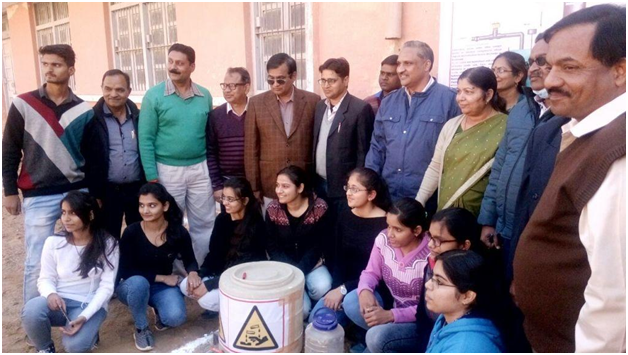LABORATORY WASTE WATER NEUTRALIZATION PLANT


Objectives of the Practice:
• The prime objective of the practice is to control water quality deterioration being created due to experiments performed in institutional laboratories
• To train students for water analysis and create environmental concern among them.
• To design experiments from waste water and performing the task of recovery of heavy metals
• To heck the effect of laboratory waste water on different plants, particularly desert plants
• To develop solar distillation plant for the preparation of distilled water from laboratory waste water.
The Context:
It is well known fact that laboratory waste particularly of Chemistry lab waste involves several toxic and hazardous chemicals including mineral acids like hydrochloric, sulfuric and nitric acid. These acids, alkalis and other chemicals come out with waste water and if disposed directly to environment without neutralization, these not only degrades the underground water quality but also deteriorate the soil quality drastically when exposed for prolonged period of time. When we are talking about waste water management, the disposing / recycling, pollution control and Green campus etc. are also included. It is important to make sense of waste water treatment and recycling in colleges and / institution laboratories.
The Practice:
It is being taught regularly and periodically that acidic, alkaline waste and other wastes disposals coming out from laboratories are toxic, hazardous and dangerous. Further pH calculations and determination of in the labs
Evidence of Success
The project has been designed in three parts.
In part I of the project, the waste water produced is collected from the lab, its pH is measured daily and accordingly a calculated amount of neutralizer is added to maintain its pH thereafter it is released. This part of the project is running successfully.
In part II of the project, estimation, pre-concentration and removal of metals and toxic materials present in laboratory waste water is being done and this part is in process.
In part III of the project, preparation of distilled water from laboratory waste water is planned, for this purpose a solar distillation plant has been designed and fabricated in chemistry department.
The project is first of its kind and not only a good source of teaching – learning methodology but also a Green chemical Technology step toward Green Auditing.
The data collected from the year 1.07.2018 to 30.01.2019 has been presented in the form of a poster during national conference held at Bikaner by a group of students.
On the development of process and functioning of complete plant a science film has been produced by the students named as “Saviours of Water”. The movie has been awarded as special jury award during IISF 2019 held at Kolkata in Oct 2019.
(Photographs of different stages are attached)
Problems Encountered and Resources Required
(a) Collection of waste water in a separate neutralization tank was initial problem because it requires a separate construction and repair work.
(b) Neutralization material and its finalization was one big challenge because it should have following specifications – economic material, non hazardous material and its end product should be useful.
(c) After the filling of end product in the water tank its removal from the tank was a problematic task which requires resource mobilization.
(d) Designing of solar plant and implementing it for the preparation of distilled water.
Notes
A unique initiative of chemistry department was to develop a pilot project of laboratory waste water neutralization plant. The liquid waste produced in the chemistry and other laboratory is highly toxic and hazardous to both life and land and equally deteriorate the quality of soil. In order to solve this problem on the basis on twelve principles of Green chemistry a pilot project was initiated. The pilot project is to neutralize the toxicity and hazardousness was conceived developed and executed in M.Sc. (P) lab of the chemistry department.
It is important to note that 1 ml of laboratory grade acid requires approximately 20000 liter of water to neutralize without addition of neutralizer.


